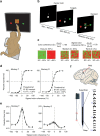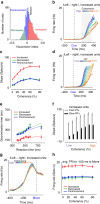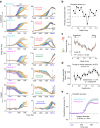Laminar differences in decision-related neural activity in dorsal premotor cortex
- PMID: 28931803
- PMCID: PMC5607001
- DOI: 10.1038/s41467-017-00715-0
Laminar differences in decision-related neural activity in dorsal premotor cortex
Abstract
Dorsal premotor cortex is implicated in somatomotor decisions. However, we do not understand the temporal patterns and laminar organization of decision-related firing rates in dorsal premotor cortex. We recorded neurons from dorsal premotor cortex of monkeys performing a visual discrimination task with reaches as the behavioral report. We show that these neurons can be organized along a bidirectional visuomotor continuum based on task-related firing rates. "Increased" neurons at one end of the continuum increased their firing rates ~150 ms after stimulus onset and these firing rates covaried systematically with choice, stimulus difficulty, and reaction time-characteristics of a candidate decision variable. "Decreased" neurons at the other end of the continuum reduced their firing rate after stimulus onset, while "perimovement" neurons at the center of the continuum responded only ~150 ms before movement initiation. These neurons did not show decision variable-like characteristics. "Increased" neurons were more prevalent in superficial layers of dorsal premotor cortex; deeper layers contained more "decreased" and "perimovement" neurons. These results suggest a laminar organization for decision-related responses in dorsal premotor cortex.Dorsal premotor cortex (PMd) is thought to be involved in making somatomotor decisions. Chandrasekaran et al. investigated the temporal response dynamics of PMd neurons across cortical layers and show stronger and earlier decision-related responses in the superficial layers and more action execution-related signals in the deeper layers.
Conflict of interest statement
The authors declare no competing financial interests.
Figures





References
Publication types
MeSH terms
Grants and funding
LinkOut - more resources
Full Text Sources
Other Literature Sources

